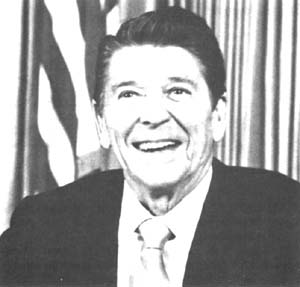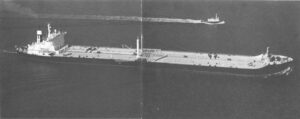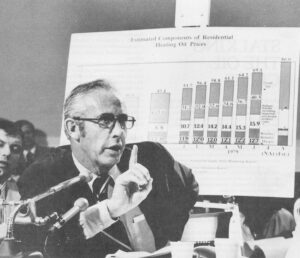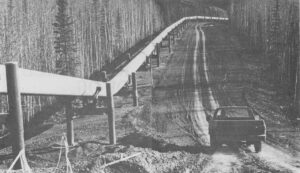WASHINGTON, D.C.–As the country struggles with the energy dilemma, something vital to the task keeps getting stolen: information.
The culprit is the executive branch of the federal government, which for the past several years has repeatedly acted as a censor and crude propagandist in energy matters. Recent energy history is littered with examples of shaky guesses presented as facts, apparent scare tactics, attempts at juggling facts to justify predetermined policy, and efforts to squelch government studies that raise questions about policies. A clear pattern of this sort ran through the Carter administration and similar incidents have begun surfacing under President Reagan.
In theory, everybody agrees that energy information is important. The country is making choices that will determine the desirability of America as a place to live. Some of the choices are Faustian bargains with danger and pollution, such as deciding how many nuclear reactors and how much coal we will need to keep the economy working. Without a free flow of energy information, without an atmosphere in government that encourages honest fact-finding, we would appear to be juggling heavy objects in the dark, barefoot.
To be sure, energy is complicated, and experts often disagree about the economic and technological assumptions behind policies. We are not talking here, though, about open debate among well-meaning officials, but about efforts by the executive branch to stifle or manipulate the energy information reaching the public and the Congress-which is, after all, the body responsible for writing the laws that make up America’s energy policy.
Government’s Relationship to Nuclear Industry
After the Reagan administration took office this year with plans to expand the nuclear industry, a nearly completed Department of Energy report to Congress on federal subsidies to nuclear power was abruptly pulled out of the normal review process and severely rewritten before its public release. Although senior DOE officials already had approved the original report, the final draft was changed to put the government’s relationship to the nuclear industry in a more favorable light.
The original study found that federal subsidies to nuclear power have been $40 billion. In the final version, this was cut to $12.8 billion. The official who changed the report, David McNicol, also removed the word “subsidy” each time it appeared replacing it with “support,” and eliminated a reference to “current uncertainty about the viability of commercial nuclear power.” The study’s original author, Joseph Bowring, charged that McNicol had responded to pressure from higher officials in DOE. McNicol denied the charge and said he rewrote the report because Bowring used a misleading definition of subsidies. McNicol’s account, however, did not explain why he had originally approved the report with the $40 billion. Bowring said, “They consider DOE’s function to be a booster of nuclear power.”
Solar Energy Report Kept Under Wraps
A major DOE study for Congress on the potential of solar energy and conservation became enmeshed in threats and secrecy, two of its authors said, after its findings conflicted with Reagan energy policy.
The solar energy study represented DOE’s first comprehensive attempt to assess the potential of solar and energy efficiency programs. It was produced by DOE’s main solar research facility, the Solar Energy Research Institute in Golden, Colorado. The researchers’ central finding was that a federal commitment to solar and efficiency could cut U.S. energy consumption by almost 25 percent by the year 2,000 without sacrificing economic growth. That finding is sharply at odds with the production-oriented energy policy of the Reagan administration, and the report’s main authors, Henry Kelly and Karl Gawell, said other DOE officials threatened them with retribution if the report were released. “We were told bluntly that we were in big trouble and they would try to eliminate our funding,” said Gawell. “It was far from a veiled threat. They told us not even to make any copies.” DOE released the report only after Congressman Richard Ottinger (D-N.Y.) learned it was being kept under wraps and demanded a copy. Both Kelly and Gawell have resigned.
“I would have thought the report would have been seen as good news for anyone interested in energy policy, ” Kelly said. “I was baffled. The only thing that makes sense is that it was a challenge to conventional wisdom, and a lot of DOE programs are built around conventional wisdom, and there was a vested bureaucratic interest in keeping the department’s priorities the way they had always been.”
Worst Case Scenario
One of President Carter’s first steps in seeking support for his pro-nuclear, pro-coal, higher-prices energy program was to release a frightening CIA report predicting that the Soviet Union would need substantial oil imports by 1985. Carter’s CIA director, Stansfield Turner, amplified the alarm in Congressional testimony, saying the U.S.S.R. and Eastern Europe would need oil imports of 3.5 to 4.5 million barrels a day by 1985-a development that could put the U.S. and Russia into a dangerous struggle for Middle East oil possibly pushing world oil prices out of sight. But a year later, with far less fanfare, the Senate Select Committee on Intelligence found that Carter used the prediction with “political motivations” to push his energy plans and that Turner failed to tell Congress what was well known within the CIA-that the prediction was a speculative, worst-case scenario that CIA energy analysts considered highly unlikely.
The CIA has since changed its position and said it foresees no Soviet oil imports during the 1980s. The committee’s report says: “On the question of whether or not there were political motivations behind the release of the CIA research, the answer is quite simple: There were. President Carter said he was going to use this information to build suport for his energy plan.”
Dubious Energy Predictions
Carter administration officials ordered the programming of questionable data into a government computer system used to forecast future energy needs-even though Congress had specified that this system was supposed to operate independently of policy making officials. The data resulted in new computer predictions of serious mid-1980s shortages suggesting a need for the Carter policies and giving the impression they had been scientifically derived. But a government audit team found the predictions dubious and reported that the computer system’s “credibility was jeopardized by energy officials’ failure to make public the nature of the changes, their rationale and their impact.”
At that time, the government’s energy computer model was the PIES system (short for Project Independence Energy System), which Congress set up with the provision that it operate independently of policy makers. However, the government’s Professional Audit Review Team, made up of members from several federal agencies later found that the Carter administration, with the approval of Energy Secretary James Schlesinger, had quietly ordered 21 changes in the model that resulted in a favorable picture of the administration’s plans.

The auditors reported that: “The net impact. . . was to increase anticipated energy demand by the equivalent of 2.52 million barrels of oil a day and to decrease anticipated estimated supply by the equivalent of 1.44 million barrels a day by 1985. The increased gap between projected energy supply and demand translated into a greater dependence on imported oil, thus emphasizing the need to implement the President’s energy plan.” Edwin Rothchild, executive director of the Energy Action Educational Foundation, investigated the changes and found that the administration programmed the computer to assume unrealistically low levels of future domestic oil production and future energy savings from conservation. “They worked it backwards,” he said. “They knew what conclusions they wanted, and they put numbers into the computer to make it back up those conclusions.”
Natural Gas Study Suppressed
Just before Carter’s April, 1977, energy speech predicting continued scarcity and calling for the “moral equivalent of war,” a Department of Energy study projecting bountiful natural gas supplies in the U.S. was suppressed. The leader of the study team, Dr. Charles Knudsen, a highly regarded geologist, was abruptly fired from the project. When the report slipped into print despite DOE’s wishes, the agency got the Government Printing Office to order its recall and destruction. Now, developments in gas exploration suggest that Knudsen’s report actually was much too conservative -far more gas is being found than he predicted.
A copy of the 1977 DOE study survived because a journalist spotted a reference to it in a Government Printing Office list. After DOE refused to give him a copy, Paul Schaffer, statistics editor of Energy User News, found one at the Newark Public Library and spent a Saturday feeding 376 dimes into a copying machine. Soon after, the GPO sent out a notice to all libraries that handle federal documents: “The Department of Energy has advised this office that the publication … should be removed from your shelves and destroyed.”
Oil Shortage?
In 1979, the Carter administration seized upon the Iranian crisis as an opportunity to reverse the steady rise in U.S. energy consumption and to enact policy measures, such as crude oil decontrol, that had been previously thwarted. The justification for this effort was the administration’s assertion that the world was suffering a two-million-barrel-a-day oil shortage in the first quarter of that year. But at the same time, the administration had confidential reports from the International Energy Agency that contradicted this view. A classified ILA report issued eight days before Carter announced decontrol says “the first quarter supply and stock situation in ILA countries,” which include the U.S., “appears by and large little different from normal.”
Despite the ILA data, the administration sought to discredit information developed by analysts working independently in the Treasury Department and the Congressional Research Service. At the Congressional Research Service, an experienced oil analyst, Dario Scuka, studied world oil production and wrote a report suggesting that the shortfall was not nearly as large as the administration claimed. When Congressman Albert Gore Jr. (D.-Tenn.) released the report, he said, “The DOE was furious and said it was irresponsible.” Exxon attacked the study as “a disservice to the country.” Gore said: “I was out on a long limb for a couple of months, but I was convinced Scuka was right. And by six months later, virtually all the experts were adopting his conclusions. “
At the Treasury Department, two energy economists Cathryn Goddard and Jay Pollach, completed a study in April, 1979, concluding that “Iran’s shortfall in exports has not produced any real shortage of crude in the U.S.” Senior Treasury officials ordered that the report not be released. The reason was outlined in an internal memo dated May 17: “DOE … is concerned over the impact that distribution of this paper, with its potentially damaging conclusions, might have on achievement of our energy policy goals.”
GAO Investigation Thwarted
A 1979 investigation into federal energy policy by a team from the General Accounting Office, Congress’s investigative arm, was thwarted by the White House’s refusal to turn over key documents, team members said in interviews. After Carter’s chief domestic policy adviser, Stuart Eizenstat, called GAO to complain about the inquiry, the team was disbanded and its highly critical findings were reduced to a bland six-page letter. The collapse of the investigation saved the administration some political embarrassment.
The investigators had obtained internal documents showing that political concerns about the 1980 presidential election figured in administration planning for decontrolling the price of crude oil. The documents, which were circulated among senior administration officials, recommended a decontrol timetable that “would push most of the inflationary effects from this action into 1981” because of concerns over the election. The plan was drafted by James Voytko of DOE’s office of policy and evaluation. The administration did not adopt all of Voytko’s suggestions on timing, but it did impose a decontrol plan under which prices were allowed to rise gradually from June 1, 1979 to October 1, 1981, deferring some of the consumer impact until after the election.
The team also had written a preliminary report accusing the administration of “an inability to foster public confidence in government as an objective source of information” and of attempts “to manipulate public opinion, attitudes and behavior with resulting pressures for higher [petroleum] prices due to government-induced panic buying.”
The GAO investigators had interviewed numerous officials in what they had been told was a high-priority inquiry into how federal energy policy is made. When they met with Eizenstat, he reacted indignantly to the team’s request to see documents the White House had used in drafting its second Congressionally mandated National Energy Plan, which had just been released, according to the team leader, Kirby Brant, and two members, Greg Daneke and Sheldon Bierman. “Eisenstat was very put out that we were even asking these questions and putting people on the spot,” said Brant. “We never got the documents.”
Challenging the Assumptions
Representative Gore, who was criticized during the 1979 crisis for releasing the Congressional Research Service report, said the impulse to suppress energy information stems from officials’ unwillingness to keep an open mind about energy trends. “They develop a vested interest in maintaining that the assumptions behind their definition of the energy crisis are the correct ones,” Gore said. “Then when someone’s study challenges the assumptions, there inevitably are tendencies to stifle or discredit.”
At a Senate Energy Committee hearing held June 23, 1977, on the controversy over the natural gas study, Senator John Durkin (D-N. H.) complained bitterly about the lack of credible energy information from the administration: “As a result, we sit here today like mapmakers of centuries ago, attempting to chart unseen lands by relying on second-hand information …. One of the government’s roles in this debate must be to provide complete and unbiased information, so that the decisionmakers can develop sound policies for the future. This has not always been the case.”
As long as the Reagan people keep copying the Carter record on energy information, Durkin’s complaint of four years ago will still sound like today’s news.
©1981 Brian Donovan
Brian Donovan, a reporter on leave from Long Island’s Newsday, is investigating U.S. petroleum policies.




